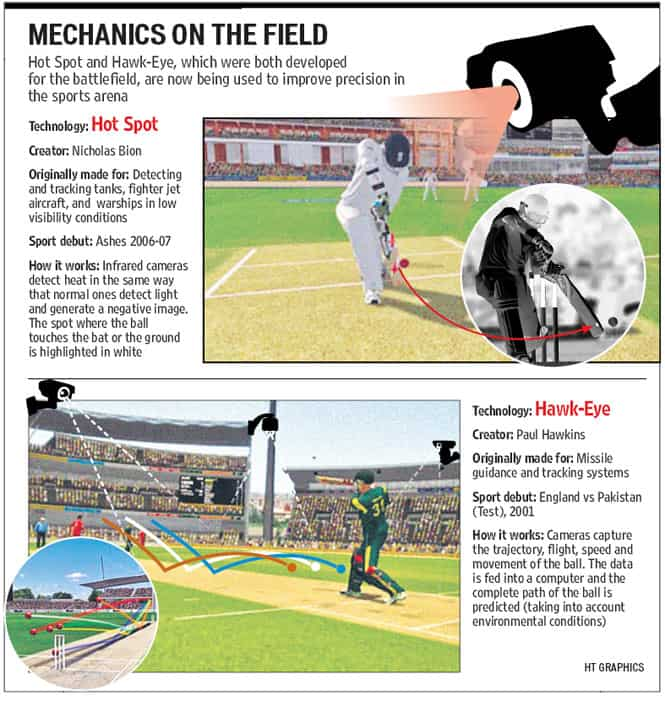The surprising friendship between cricket and military technology
Cricket with all its trappings and suits, as it happens, owes much to those who make missiles and radars. Many technologies that help make cricket ‘better’, such as Hawk-eye and Hot Spot, to name just two, owe their origin to research in military technologies.
Technology has all but taken over the way we engage with cricket (and life, one might argue). Whether it is to catch up with the score of the latest IPL league match or to analyse the batting technique of the man expected to replace Rahul Dravid as the mainstay of the test team, we have to turn to various technologies to keep us updated. That’s not all. A seemingly unrelated (to cricket) aspect of our everyday news bulletins is the mechanics of war.


Hot Spot is one of those innovations that first made its appearance in cricket as a tool to aid commentators on television, much as several other umpiring tools, such as the slow motion replay and the stump microphone. It was first used in cricket on Channel Nine during the Ashes in 2006-07. Hot Spot uses infrared camera technology to determine which part of the batsman’s body or bat made contact with the ball. Two powerful thermal-imaging cameras are placed around the field — behind the bowler’s arm at each end. These cameras identify and calculate the amount of heat generated by the impact of the ball against another object. A negative image is then generated on a computer, on which the point of contact is highlighted as a red friction “hot spot”.
This technology was originally developed for combat by military scientists. Thermal imaging technology has its use in detecting and tracking tanks, fighter jet aircraft, and other warships in the dark or across smoke-covered battle grounds. A thermal-imaging or infrared camera detects heat in the same way that normal cameras detect light. The higher an object’s temperature, the more the infrared radiation emitted.
The thermal-imaging camera can detect this radiation and creates ‘images’. This works even in total darkness because light levels don’t affect the heat generated by a body. This makes it useful for war-time efforts in the dark or even in rescue operations in smoke-filled buildings.
The technology was adapted for use on the cricket field by the Australian company responsible for the Snickometer — BBG Sports — in collaboration with Sky Sports as a tool for commentators to make the game more exciting for viewers.
Another staple in the televised cricket field is Hawk-Eye, the system that, by recreating a bowled ball’s possible trajectory, aids in making lbw (leg before wicket) decisions more accurate. This piece of technology owes its origin to research in missile guidance systems. Up to six JAI monochrome cameras (usually placed at long-on, long-off, third man, fine leg, and two square of the wicket) operate at 120 frames per second (regular television cameras operate at 25), out of which three capture the path of the ball from each end, and the pictures from each of those cameras are fed into a central computer. The cameras capture the trajectory, flight, speed, and movement of the ball from the bowler’s hand to the point it bounces on the pitch, and then from the instant it bounces off the pitch to the moment it makes contact with the batsman’s pad or his bat. The computer then extrapolates this information to predict the path of the delivery. This is a bold step into a new realm of technological influence in sports as this is technology indulging in conjecture by predicting possibilities.
While the use of such technology has largely been applauded by experts and laymen alike, questions about accuracy have been raised not just in cricket but also in tennis. Who can forget Roger Federer finding himself at the wrong end of an obvious error by the machine during the Wimbledon finals of 2007?
A paper written by Harry Collins and Robert Evans of Cardiff University’s School of Social Science discusses the advertised margins of error by the company that provides Hawk-Eye technology, and concludes that since the advertised margin is an ‘average’ of 3.6 millimetres, it stands to reason that there are occasions when the margin of error can be greater.
The man who invented Hawk-Eye, Dr Paul Hawkins of Roke Manor Research near Southampton, UK, is a former Buckinghamshire cricketer who boasts of a PhD in artificial intelligence. The technology is derived from the military technology that was originally used in top secret missile guidance and tracking systems. The same technology has also been adapted for use in brain surgery. As more money is pumped into the game, expensive technologies (Hot Spot costs $6000 per day for the use of two cameras, which is why it was not used in the World Cup in 2011), from the bunkers of war research and from more conventional areas of study too, will quickly make their way onto the cricket fields.
(Vidya Subramanian is a doctoral candidate at the Centre for Studies in Science Policy, Jawaharlal Nehru University)
Stay updated with the latest Cricket News, IPL Live Score, GT vs DC Live Score and get exclusive insights with the IPL Match Today, IPL Points Table match highlights, and more. Explore a comprehensive Cricket Schedule, track the race for the Purple Cap and IPL Orange Cap in IPL 2024, check Virat Kohli performance and stay ahead with all the cricket-related updates on the Hindustan Times website and app.





